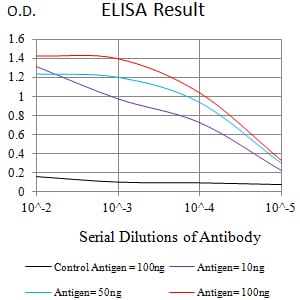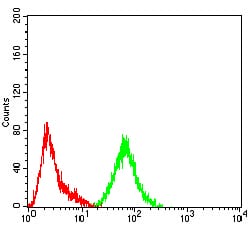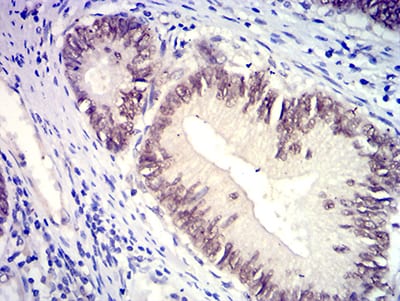


| WB | 咨询技术 | Human,Mouse,Rat |
| IF | 咨询技术 | Human,Mouse,Rat |
| IHC | 1/200 - 1/1000 | Human,Mouse,Rat |
| ICC | 技术咨询 | Human,Mouse,Rat |
| FCM | 1/200 - 1/400 | Human,Mouse,Rat |
| Elisa | 1/10000 | Human,Mouse,Rat |
| Aliases | GLSS |
| Entrez GeneID | 23314 |
| clone | 7B2E11 |
| WB Predicted band size | 82.6kDa |
| Host/Isotype | Mouse IgG1 |
| Antibody Type | Primary antibody |
| Storage | Store at 4°C short term. Aliquot and store at -20°C long term. Avoid freeze/thaw cycles. |
| Species Reactivity | Human |
| Immunogen | Purified recombinant fragment of human SATB2 (AA: 377-499) expressed in E. Coli. |
| Formulation | Purified antibody in PBS with 0.05% sodium azide |
+ +
以下是关于SATB2抗体的3-4篇参考文献的简要信息:
1. **文献名称**: "SATB2 is a Novel Marker for Colorectal Adenocarcinoma"
**作者**: Magnusson K. et al. (2016)
**摘要**: 该研究验证了SATB2抗体作为结直肠癌特异性标记物的有效性,发现其表达在结直肠腺癌中高度敏感且特异,优于传统标记物CDX2.可辅助病理诊断。
2. **文献名称**: "SATB2-associated Syndrome: Clinical and Molecular Characterization"
**作者**: Zimmerman S. et al. (2017)
**摘要**: 本文探讨SATB2基因突变引起的神经发育障碍(如智力障碍、语言缺失),并通过小鼠模型揭示SATB2在皮质神经元发育中的作用,支持其作为神经病理标记的潜力。
3. **文献名称**: "Utility of SATB2 Immunohistochemistry in Distinguishing Gastrointestinal Carcinomas"
**作者**: Lin F. et al. (2018)
**摘要**: 研究比较SATB2与CK20、CDX2在胃肠道癌中的表达,证明SATB2对结直肠癌诊断特异性高(约95%),尤其在转移性癌鉴别中具有重要价值。
4. **文献名称**: "SATB2 Expression in Osteosarcomas and Its Diagnostic Implications"
**作者**: Dobi A. et al. (2019)
**摘要**: 该文献发现SATB2在骨肉瘤中广泛表达(约80%病例),可作为区分骨肉瘤与其他肉瘤的标记物,但其特异性较低,需结合其他标记物使用。
这些文献覆盖了SATB2抗体在肿瘤诊断(如结直肠癌、骨肉瘤)及神经发育研究中的应用,反映了其多领域价值。
SATB2 (Special AT-rich sequence-binding protein 2) is a nuclear matrix-associated transcription factor that plays critical roles in transcriptional regulation, chromatin remodeling, and epigenetic modifications. It is primarily expressed during embryonic development, particularly in tissues derived from the neural crest, such as the craniofacial skeleton and the central nervous system. SATB2 is essential for osteoblast differentiation, palate formation, and neuronal development, with mutations linked to human syndromes featuring intellectual disability, craniofacial abnormalities, and dental defects.
In diagnostic pathology, SATB2 antibodies are widely used as immunohistochemical markers. SATB2 is highly specific for tissues of osteoblastic and neuronal origin, making it valuable in identifying osteosarcomas, colorectal adenocarcinomas, and certain neural tumors. Its expression in colorectal cancer (≈85-90% positivity) helps distinguish it from other gastrointestinal or gynecological malignancies. Additionally, SATB2 is employed to study neurodevelopmental disorders and craniofacial malformations. As a research tool, SATB2 antibodies aid in investigating gene regulatory networks involving SATB2’s binding to nuclear matrix attachment regions (MARs), which organize chromatin architecture to modulate gene expression. Its dual role in both developmental biology and cancer continues to drive interdisciplinary research interest.
×